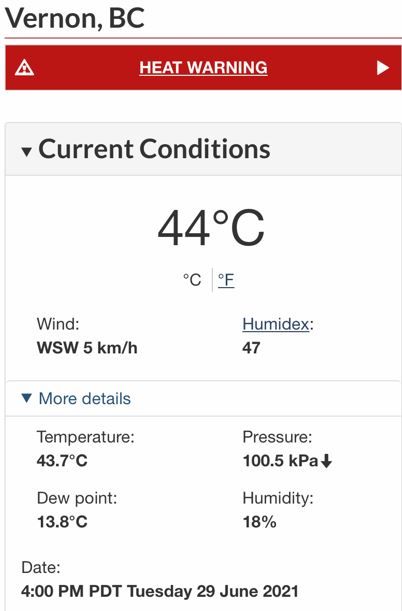Investigation into heat dome deaths leads to several recommendations

A panel of experts tasked with reviewing the deaths linked to the 2021 heat dome in British Columbia has released a report that includes several recommendations.
The findings from the Extreme Heat and Human Mortality: A Review of Heat-Related Deaths in B.C. in Summer 2021 report by the B.C. Coroner’s Service was released on Tuesday
The Coroner’s Service investigated over 800 deaths recorded between June 25 and July 1, 2021, when daytime temperatures were over 40 degrees Celsius in many parts of the province. The results of that process found that 619 were heat-related deaths.
The report also noted that 84, or 14 per cent, of the overall heat-related deaths, happened in the Interior. The only local communities included in the report were Kelowna with 15 deaths and Kamloops with 17.
Other findings outlined in the report include:
- 98 per cent of deaths occurred indoors (73 per cent in private residences [39 per cent in multi-unit buildings and 34 per cent in detached buildings]; 10 per cent in social housing, single room occupancy or supportive housing; seven per cent in trailer homes, mobile homes, RVs or campers; seven per cent in senior or long-term care homes);
- There was a lag between the heat alerts issued by Environment and Climate Change Canada and public agencies and the public response;
- Heat-related deaths were higher among people on specific chronic disease registries, including schizophrenia, substance-use disorder, epilepsy, chronic obstructive pulmonary disease, depression, asthma, mood and anxiety disorder, and diabetes, compared to the B.C. population;
- More than 60 per cent of decedents had seen a medical professional within the month prior to their death;
- 67 per cent of the people who died were age 70 or older (90 per cent were aged 60 and over);
- 56 per cent of decedents lived alone;
- Compared to the general population, more decedents lived in socially or materially deprived neighbourhoods;
- More of the victims were in homes without adequate cooling systems, such as air conditioners or fans;
- 74 per cent of deaths occurred in Fraser (50 per cent or 312 deaths) and Vancouver Coastal (23 per cent or 145 deaths) health authorities; 14 per cent or 84 deaths were reported in the Interior;
- Fraser North, Fraser East and Vancouver had the highest rates of deaths by Health Services Delivery Area;
- 911 calls doubled during the peak of the heat dome;
- Paramedics attended 54 per cent of deaths with a median time of 10 minutes and 25 seconds;
- In 50 instances, paramedics took 30 minutes or longer from the time of the call until they arrived at the scene;
- In 17 instances, 911 callers were placed on hold for an extended period of time;
- In six instances, callers were told that there was no ambulance available at the time of their call.
-
-
 Temperature was near 44 degrees in Vernon on June 29, 2021. (Image credit: Environment Canada)
Temperature was near 44 degrees in Vernon on June 29, 2021. (Image credit: Environment Canada)
-
The report noted that during the 2021 heat dome, there were no heat-related deaths in people under the age of 30, including no infants or children.
The findings also show that 33.4 per cent, or 207 of the deaths, occurred in temperatures between 35 and 39 Celsius. There were 177 deaths, or 28.6 per cent of the total, recorded during temperatures between 30 and 34 C, while 172, or 17.8 per cent of heat-related deaths, occurred when the temperature was 40 C or higher.
To mitigate the risks of future extreme heat events causing more deaths in B.C., the expert panel that compiled the report issued three recommendations for provincial action:
Implement a coordinated provincial heat alert and response system (HARS)
“Panel discussions identified the need to establish clear provincial protocols and outline actions to be initiated when either a heat warning or an extreme heat emergency alert is issued,” stated Dr. Jatinder Baidwin, chief medical officer for the B.C. Coroner’s Service.
“The panel recognizes a need for overall provincial coordination since, like other natural disasters, an extreme heat emergency event is a provincial emergency and may require access to additional services.”
He added there is a need for regional and local decision making, as local governments best understand the needs of their communities, and that local and regional action plans should be triggered in the event of an extreme heat emergency alert being issued.
The province did announce Monday that a heat alert system is being put in place using the current Alert Ready program.
Identify and support populations most at risk of dying during extreme heat emergencies
“Not all people experience the same level of health risk during an extreme heat event,” said Baidwin.
“The elderly persons with chronic health conditions, persons living alone, those with no access to cooling, and those in particular geographic areas were more impacted.”
He stated that wider public awareness community-specific education and training on recognizing heat concerns and who is most vulnerable are necessary, as are universal safety measures and warnings across all of B.C.
“Two of the most impactful interventions during a heat event are ensuring people have a way of staying cool, either inside their residence or elsewhere, and conducting informed checks on older adults, persons with health conditions, those living alone, and those with mobility issues, to consult and work with them on their well-being and support needs.”
Baidwin added that any strategies developed locally, regionally or provincially should be informed by input from the most vulnerable populations.
Implement extreme heat prevention and long term risk mitigation strategies
“Adaptation and risk mitigation becomes more urgent with increasing likelihood of more frequent extreme heat events due to the impacts of climate change,” said Baidwin.
Those mitigation strategies could include increasing shading and green space; more heat reflectivity; updating building codes to require passive and active cooling, and retrofitting codes and rebate programs that encourage passive and active cooling measures in current housing.
Baidwin noted that if building codes are revised, they should match the latest climate science.
In addition to issuing the recommendations for the province, Baidwin reminded people to be aware of the signs of heat-related illnesses in themselves or others. Those symptoms can include headache, nausea, dizziness, weakness, irritability, thirst, heavy sweating, and elevated body temperature. In the event of having these symptoms, it’s advised that the person be moved to a cool, shaded space and seek medical attention.
He also advised people have plans to check in on friends, family and neighbours, especially if they are among the most vulnerable groups, and to adhere to the plans.
“We know that future heat events like last summer’s are certain to occur,” said Baidwin.
“Together we can ensure that we are ready to respond and avoid eminently preventable loss of life.”
The province has also created a Heat Preparedness Guide for British Columbians to consult to ensure they are ready for any future heat events.

